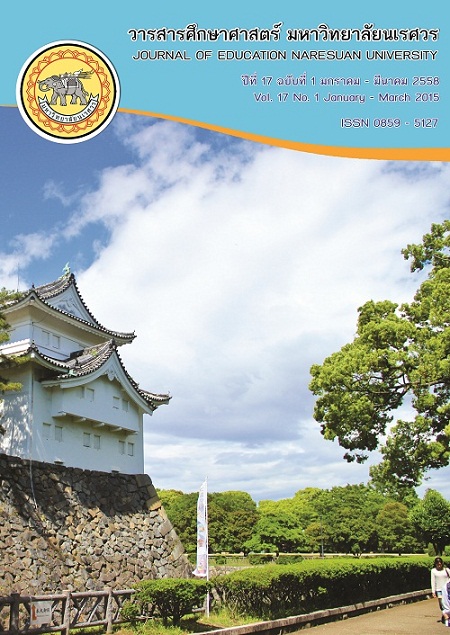การพัฒนาหลักสูตรเสริมสร้างจิตสำนึกในการเตรียมความพร้อมรับมือภัยพิบัติ ตามแนวคิดจิตตปัญญาศึกษา สำหรับนักเรียนระดับมัธยมศึกษาตอนต้น
Main Article Content
Abstract
บทคัดย่อ
การวิจัยครั้งนี้มีจุดมุ่งหมายเพื่อพัฒนาหลักสูตรเสริมสร้างจิตสำนึกในการเตรียมความพร้อมรับมือภัยพิบัติ ตามแนวคิดจิตตปัญญาศึกษา สำหรับนักเรียนระดับมัธยมศึกษาตอนต้น ดำเนินการวิจัยโดยใช้กระบวนการวิจัยและพัฒนา 4 ขั้นตอน โดยผู้วิจัยให้ความสำคัญกับขั้นตอนที่ 1 การศึกษาข้อมูลพื้นฐาน ซึ่งเป็นขั้นตอนที่นำข้อมูลและสารสนเทศมาตัดสินใจในการออกแบบและกำหนดองค์ประกอบหลักสูตรเพื่อให้สอดคล้องกับสภาพปัญหาและความต้องการของชุมชนที่อยู่ในพื้นที่ประสบภัยพิบัติน้ำท่วมบางระกำ โดยสัมภาษณ์เชิงลึกกลุ่มผู้ให้ข้อมูล 3 กลุ่ม ได้แก่ กลุ่มนักวิชาการระดับประเทศและผู้ปฏิบัติหน้าที่เกี่ยวกับภัยพิบัติ จำนวน 11 ท่าน กลุ่มผู้มีส่วนเกี่ยวข้องในชุมชนบางระกำ จำนวน 9 ท่าน และกลุ่มผู้เชี่ยวชาญด้านจิตตปัญญาศึกษา จำนวน 7 ท่าน รวมถึงศึกษาสภาพจิตสำนึกในการเตรียมความพร้อมรับมือภัยพิบัติของนักเรียนชั้นมัธยมศึกษาปีที่ 1 โรงเรียนบางระกำ อำเภอบางระกำ จังหวัดพิษณุโลก จำนวน 41 คน ขั้นตอนที่ 2 การสร้างและตรวจสอบคุณภาพของหลักสูตร โดยผู้เชี่ยวชาญตรวจสอบความเหมาะสมและนำหลักสูตรไปทดลองนำร่องเพื่อศึกษาความเป็นไปได้ ขั้นตอนที่ 3 การทดลองใช้หลักสูตรกับกลุ่มตัวอย่างเป็นนักเรียนชั้นมัธยมศึกษาปีที่ 1 โรงเรียนบางระกำวิทยศึกษา อำเภอบางระกำ จังหวัดพิษณุโลก ภาคเรียนที่ 1 ปีการศึกษา 2556 จำนวน 31 คน ได้มาจากการสุ่มแบบแบ่งกลุ่ม ใช้เวลาทดลอง 20 สัปดาห์ 40 ชั่วโมง โดยประยุกต์ใช้กระบวนการเรียนรู้จิตตปัญญาศึกษา 3 ขั้นตอน ได้แก่ ขั้นที่ 1 การสร้างสติ ขั้นที่ 2 การลงมือปฏิบัติ และขั้นที่ 3 การสะท้อน ขั้นตอนที่ 4 การประเมินผลหลักสูตร โดยสอบถามความคิดเห็นของนักเรียน และสัมภาษณ์ผู้มีส่วนเกี่ยวข้องที่มีต่อการเข้าร่วมกิจกรรมการเรียนรู้ของหลักสูตร การวิเคราะห์ข้อมูลเชิงปริมาณใช้สถิติ ค่าร้อยละ ค่าเฉลี่ย ความเบี่ยงเบนมาตรฐาน และการทดสอบค่าที (t-test) ส่วนข้อมูลเชิงคุณภาพใช้วิธีการวิเคราะห์เนื้อหา ผลการวิจัยพบว่า
1. หลักสูตรเสริมสร้างจิตสำนึกในการเตรียมความพร้อมรับมือภัยพิบัติ ตามแนวคิดจิตตปัญญาศึกษา สำหรับนักเรียนระดับมัธยมศึกษาตอนต้นประกอบด้วย 10
องค์ประกอบ คือ หลักการและเหตุผล วิสัยทัศน์ พันธกิจ จุดมุ่งหมายของหลักสูตร สาระการเรียนรู้ของหลักสูตร คำอธิบายรายวิชา โครงสร้างรายวิชา แนวทางการจัดกิจกรรมการเรียนรู้ แนวทางการใช้สื่อและแหล่งเรียนรู้ และแนวทางการวัดและประเมินผล หลักสูตรมีสาระการเรียนรู้สอดคล้องกับชุมชนที่ตั้งอยู่พื้นที่ประสบภัยน้ำท่วมและพัฒนาขึ้นจากการบูรณการสาระการเรียนรู้ในการเตรียมความพร้อมรับมือภัยพิบัติที่จำเป็นต่อนักเรียนสาระการเรียนรู้ท้องถิ่นน้ำท่วมบางระกำ ตัวชี้วัดสาระการเรียนรู้แกนกลางการศึกษาขั้นพื้นฐาน 2551 และแนวคิดบางระกำโมเดล แบ่งเป็น 4 หน่วยการเรียนรู้ ได้แก่ 1) สภาพภูมิศาสตร์กับน้ำท่วมบางระกำ 2) ลม ฟ้า พยากรณ์ 3) วิถีชีวิตอยู่กับน้ำของชาว
บางระกำ 4) รับมือ ร่วมใจ ลดภัยพิบัติ การจัดกิจกรรมการเรียนรู้ของหลักสูตรประยุกต์ใช้กระบวนการเรียนรู้จิตตปัญญาศึกษา 3 ขั้นตอน คือ MAR ขั้นที่ 1 การสร้างสติ (Mindfulness) ผ่านการฝึกปฏิบัติด้วยความสงบนิ่งหรือเคลื่อนไหว ขั้นที่ 2 การลงมือปฏิบัติ (Action) และขั้นที่ 3 การสะท้อน (Reflection) การตรวจสอบคุณภาพหลักสูตรและเอกสารประกอบหลักสูตร พบว่ามีความเหมาะสมอยู่ในระดับมาก และการศึกษานำร่องพบว่าหลักสูตรสามารถนำไปใช้ได้จริง
2. ผลการทดลองใช้หลักสูตร พบว่า 1) นักเรียนมีความรู้จากการเรียนรู้ตามหลักสูตรทั้ง 4 หน่วย หลังการทดลองสูงกว่าก่อนการทดลองใช้หลักสูตรอย่างมีนัยสำคัญทางสถิติที่ระดับ .05 2) นักเรียนมีทักษะในการเตรียมความพร้อมรับมือภัยพิบัติ ได้แก่ ทักษะการพายเรือ ทักษะการปฐมพยาบาลคนจมน้ำ และทักษะการช่วยเหลือคนจมน้ำ หลังการทดลองใช้หลักสูตรคิดเป็นร้อยละ 70.80 ซึ่งสูงกว่าเกณฑ์ร้อยละ 60 อย่างมีนัยสำคัญทางสถิติที่ระดับ .05 3) นักเรียนมีจิตสำนึกในการเตรียมความพร้อมรับมือภัยพิบัติอยู่ในระดับจัดระบบมากที่สุด คิดเป็นร้อยละ 83.87 ทั้งนี้นักเรียนทุกคนมีการเปลี่ยนแปลงระดับจิตสำนึกจากระดับต่ำไปสูง 4) นักเรียนมีจิตสำนึกในการเตรียมความพร้อมรับมือภัยพิบัติหลังการทดลองสูงกว่าก่อนการทดลองใช้หลักสูตรอย่างมีนัยสำคัญทางสถิติที่ระดับ .05 นอกจากนี้มีการเปลี่ยนแปลงสำคัญที่เกิดขึ้นกับนักเรียน ได้แก่ 1) นักเรียนมีความตระหนักรู้ในตนเองมีมุมมองเกี่ยวกับสาเหตุและการลดภัยพิบัติที่ชัดเจนขึ้น เข้าใจถึงสาเหตุและแนวทางแก้ปัญหาน้ำท่วมของชุมชนบางระกำที่ยั่งยืน 2) นักเรียนมีจิตสำนึกร่วมต่อการจัดการภัยพิบัติในโรงเรียนและชุมชน เห็นคุณค่าในภูมิปัญญาท้องถิ่น มีสติมีความสามารถในการตัดสินใจแก้ปัญหา มีความเชื่อมั่นในตนเอง มีภาวะผู้นำ กล้าเผชิญกับความเสี่ยง รู้จักเห็นอกเห็นใจผู้อื่น มีความรับผิดชอบและมีกระบวนการทำงานกลุ่มดีขึ้น
3. ผลการประเมินผลหลักสูตร พบว่า 1) นักเรียนมีความคิดเห็นต่อการเข้าร่วมกิจกรรมการเรียนรู้ของหลักสูตรอยู่ในระดับมากที่สุด โดยเห็นว่ากิจกรรมการเรียนรู้สามารถเชื่อมโยงให้นักเรียนตระหนักรู้ว่าตนเป็นส่วนหนึ่งที่ทำให้เกิดภัยพิบัติมากที่สุด
2) ผู้มีส่วนเกี่ยวข้องมีความคิดเห็นว่าหลักสูตรมีความเหมาะสมอยู่ในระดับมากที่สุด โดยเห็นว่าหลักสูตรส่งผลกระทบในทางบวกทั้งต่อนักเรียน โรงเรียน และชุมชน ประเด็นที่น่าสนใจคือหลักสูตรส่งผลให้ชุมชนตื่นตัวเห็นความสำคัญของการเตรียมความพร้อมรับมือภัยพิบัติมากขึ้น ชุมชนมีมุมมองว่าเด็กและเยาวชนคือพลังสำคัญในการจัดการภัยพิบัติจากเดิมที่มองว่าเด็กเป็นภาระ
คำสำคัญ : การพัฒนาหลักสูตร/ จิตสำนึก/ การเตรียมความพร้อมรับมือภัยพิบัติ/
จิตตปัญญาศึกษา
Abstract
This research aimed at developing curriculum to enhance consciousness on disaster preparedness based on contemplative education approach for lower secondary students. This study was conducted through research and development methodology. There were four steps in curriculum development process. Among these, the author put the strong focus at the first step; Step 1 Identifying situation and needs due to flood disaster at Bangrakam which have been used for designing curriculum and attaining curriculum components. In this step, it was consisted of three different groups of key informants ; eleven disaster-relevant experts and disaster at national level and disaster authorities, nine Bangrakam stakeholders and seven contemplative educators, coupled with 41 current students’ prior consciousness on disaster preparedness. Step 2 Constructing curriculum and verifying curriculum quality with the concurrence of the experts in Education and curriculum taken to do pilot study for the feasibility. Step 3 Implementing the curriculum with the sample group of 31 Mathayomsuksa 1 students, studying in the first semester of the 2012 at Bangrakamwittayasuksa School, Bangrakam District, Phitsanulok Province selected by cluster random sampling. 20 weeks, 40 hours have been taken for the implementation. The instruction was applied by using three steps of the contemplative education approach ; the first is ‘mindfulness’, the second is ‘action’ and the last is ‘reflection’. Step 4 Evaluating curriculum by evaluating the students’ and stakeholders’ opinions towards the curriculum with evaluation form and interview. Quantitative data was analyzed with percentage, mean, standard deviation, and t-test whereas qualitative data was analyzed by content analysis. The results can be summarized as follows;
1. The disaster curriculum to enhance consciousness on disaster preparedness based on contemplative education approach for lower secondary students comprises of 10 elements, including rationale, vision, mission, curriculum objectives, contents, course descriptions, course outline, learning schedule structure, guidelines for learning materials and learning resources, guidelines for learning assessment. The content was used in flood risk community that was integrated contents between disaster preparedness content, Bangrakam flood local-related content, the indicators of basic education core curriculum and Bangrakam Model, and divided into four unit plans. The instruction was applied by using three steps of the contemplative education approach call MAR; the first is ‘Mindfulness that the students were practiced through stillness. or movement, the second is ‘Action’ and the last is ‘Reflection’. The curriculum and supplementary documents were appropriate at high level. The curriculum was then piloted for the further improvement. Its result was at high level of appropriateness and then ready for the implementation.
2. The implementation of the curriculum was found that;
1) students acquired higher disaster preparedness knowledge with statistical significant at the level of .05. 2) students’ disaster preparedness skill (boating skill, first aid CPR, rescue drowning man) was 70.80 percent, higher than 60 percent which was criterion score, with statistical significant at the level of .05. 3) students’ disaster preparedness consciousness at the highest of the organization level, 83.87 percent and all of the students transformed their consciousness from lower to be higher level 4) students acquired higher disaster preparedness consciousness, with statistical significant at the level of .05. Moreover, the students’ changes were found that 1) they obtained self-awareness and perspective for disaster causes and disaster decrease clearly. They realized how to solve flood problem in Bangrakam district sustainable, 2) the students acquired the consciousness about disaster management in their school and community. They comprehended the value for the local wisdom, obtained the mindfulness, decision making for problem solving, self confident, leadership and they could confront with a risk. They perceived empathy, responsibility and group process.
3. The evaluation of the curriculum were found that
1) students’ opinion was at the highest level. Learning activities was stated letting them aware they might be the ones who brought about natural disaster. 2) The stakeholders’ opinion was at the highest level. The curriculum was stated giving positive impact on students, school and community. Interestingly, the curriculum could change people in Bangrakam community to be more active and more aware of disaster preparedness. Community perceived children and teenagers became the main force of disaster management. This was opposite to the past that these groups of people were thought as community burden during flood disaster.
Article Details
The owner of the article does not copy or violate any of its copyright. If any copyright infringement occurs or prosecution, in any case, the Editorial Board is not involved in all the rights to the owner of the article to be performed.


